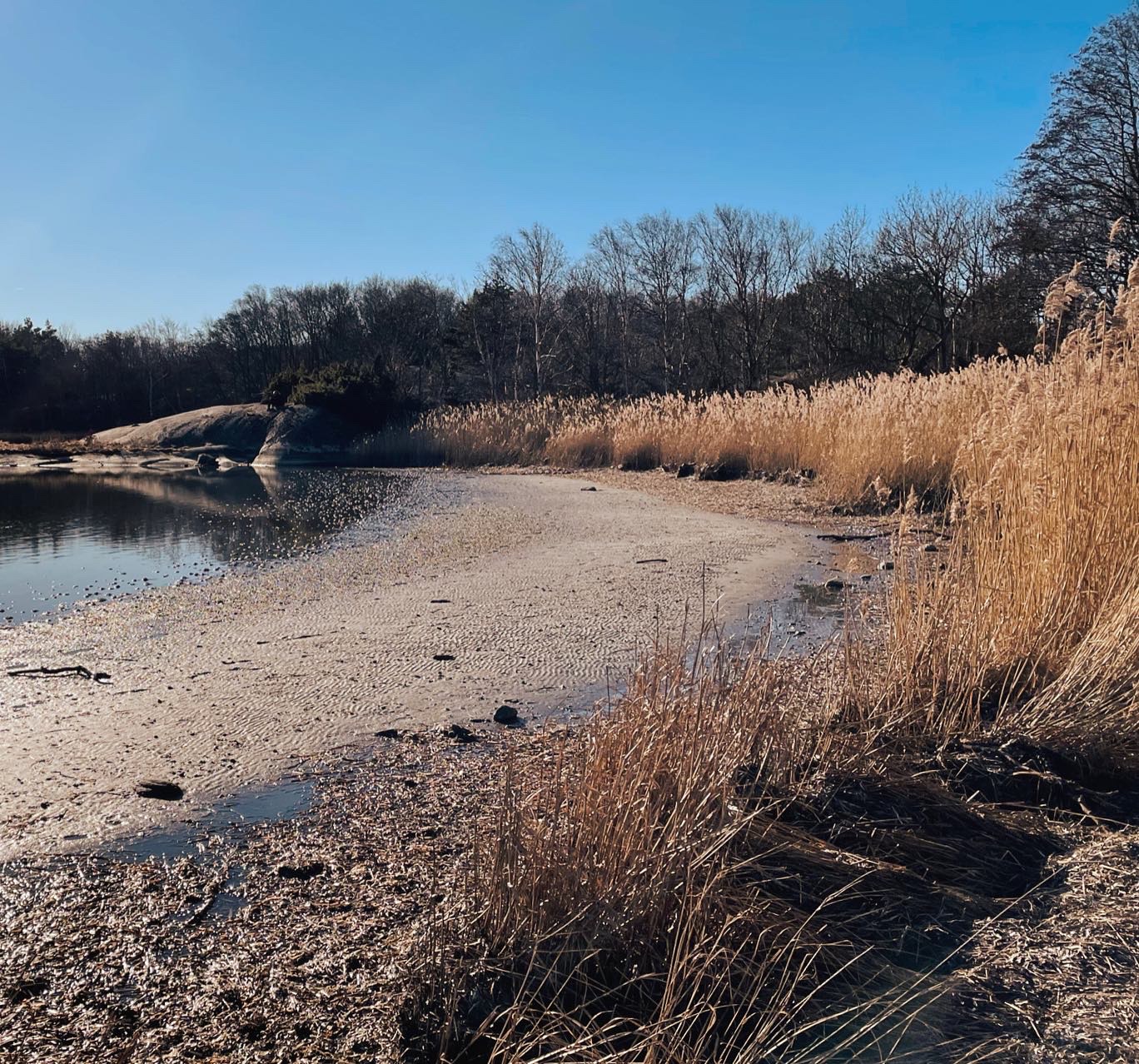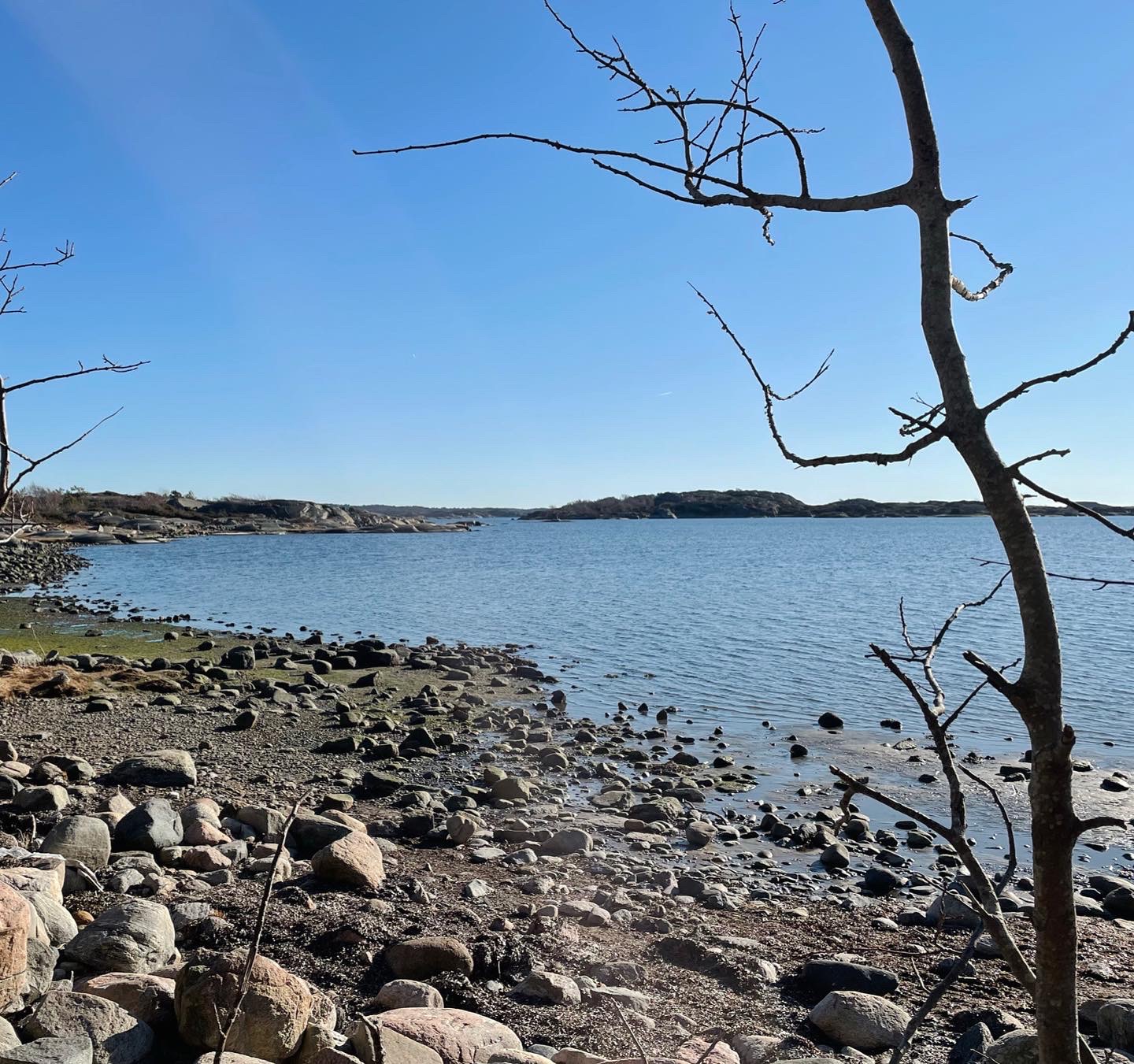Recently, I was interviewed by Queers of the World, where I shared some of my experiences as a trans researcher STEM. Watch below to hear more.
Name & Gender Marker Change Process
I’m perpetually behind with updating this and I have plenty of other updates, but those will need to be summarized in a different post. As previously promised, I wanted to outline the process I took to update my name and gender marker as a US citizen living in Sweden in hope this is helpful for someone else. This was not a very intuitive process and required hours of research and some uncertainty. This worked for me, but I cannot guarantee it would work in all situations, nor am I offering official legal or immigration advice (proceed at your own risk).
Unlike guides for doing this within the US, which suggest updating your name with US social security first, I had to start with my passport because the name change was done abroad (I don’t maintain residency in a US state and do not otherwise have the ability to obtain a US court order of name change). Here is a flowchart of how I worked through the various agencies:
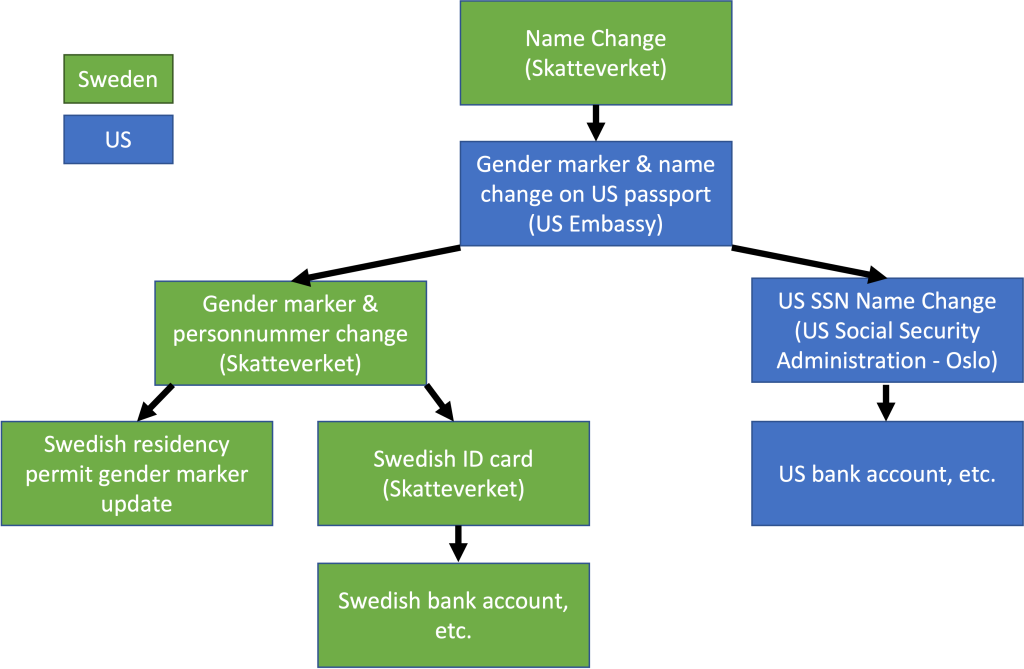
Here’s a more detailed account:
- Name change through Skatteverket. This can be done online by logging into Mina Sidor on Skatteverket’s website, costs 250 SEK. If you pick a name that is on their “common names list” (Tristan is), you will get official notification of the name change being complete within 5 minutes in your digital mailbox. Otherwise, it may take 3 months to complete the change. This was mindbogglingly easy to do and the change was instantaneous!
- Gender marker change through the US Embassy in Stockholm. I had to make the appointment 4 months in advance (something to keep in mind when doing the name change). Gender marker is self-declared for US passports now, so I just checked the “male” box and that was done. At the same time, I changed my name on my US passport using the name change documentation from Skatteverket (which they accept at the US Embassy in Stockholm). I also requested a “certified copy” of my passport (need this to update your name with US social security).
- US Social Security Number: About 1 week later, I received my new passport in the mail. I mailed the certified copy of my passport and the appropriate forms (note: this is just a piece of paper) to the US Social Security office in Norway (not intuitive!) to do the name change on my social security card.
- Skatteverket (personnummer & gender marker): I brought my US passport with the gender marker change to my local Skatteverket office to initiate the gender marker change/personnummer change in Sweden. Here (in Swedish) is the documentation that you do not need Swedish “trans diagnosis” for gender marker change if you are a foreign resident in Sweden and your foreign ID does not match your Swedish ID. With my new passport, I also submitted a foreign “trans diagnosis” letter (I don’t believe this should be necessary, but if you have it, might was well bring it). The person I talked to at the Skatteverket office was unsure this would work and said it might have to get approved by Socialstyrelsen (note: this is incorrect), but within 2 weeks, I received notification that the personnummer change went through successfully! As a foreigner, I opted to not make my old personnummer secret to ensure ease of transferring my accounts. Once the new personnummer was generated, I lost access to some online functionality associated with the old personnummer (like 1177), while being unable to use the new one because I didn’t yet have the new BankID. Prepare for 1-3 months of incomplete functionality of some online systems.
- Swedish residence permit: Once the change has been completed through Skatteverket, you can update your residence permit (gender marker must match your personnummer, so this cannot be changed until Skatteverket completes the personnummer request). I also learned that it can take about 1 week between when Skatteverket sends you the official new personnummer letter and when it gets populated through the system for Migrationsverket. I recommend making the appointment at Migrationsverket at least 1 week after otherwise you’ll have to make more than one trip.
- Swedish ID card (the one from Skatteverket): you’ll need a new one to update your Swedish bank account, BankID, etc. Prepare to wait a bit for the new ID card – they had to send it through Stockholm to cancel my old one. This took about 6 weeks to get the new one. Here is a good resource for updating your personnummer on various accounts. I bank with Nordea, and once I had the new ID card, it was very easy to get everything switched over/new BankID. My old card under the old personnummer worked until they generated the new card, which I received in the mail 2 days later.
- Accounts in the US: Will need updated US passport and social security card. Unfortunately, most of these required an in-person appointment.
Please feel free to reach out if you have questions! I was prepared for this process to be more challenging, but it was mostly smooth for me (most annoying parts were updating my US bank accounts and transferring högkostnadsskydd to the new personnummer – but both were entirely doable) .
New Milestones
This last month has been a whirlwind between various projects and travel. I’ve been away for most of the last two weeks and will be off again next week.
A paper that I am co-author on received substantial media attention a few weeks ago, which meant I pretty much dedicated an entire week spanning all waking hours to giving interviews. It was really an honor to contribute to this project and even more so that it was so widely covered in the media!!
Amongst the excitement from the release of the paper (which is also my first publication solely published under Tristan!), I also had to reconcile my feelings about feeling somewhat exposed on a very public stage as trans. It all started when I was asked for a head shot.
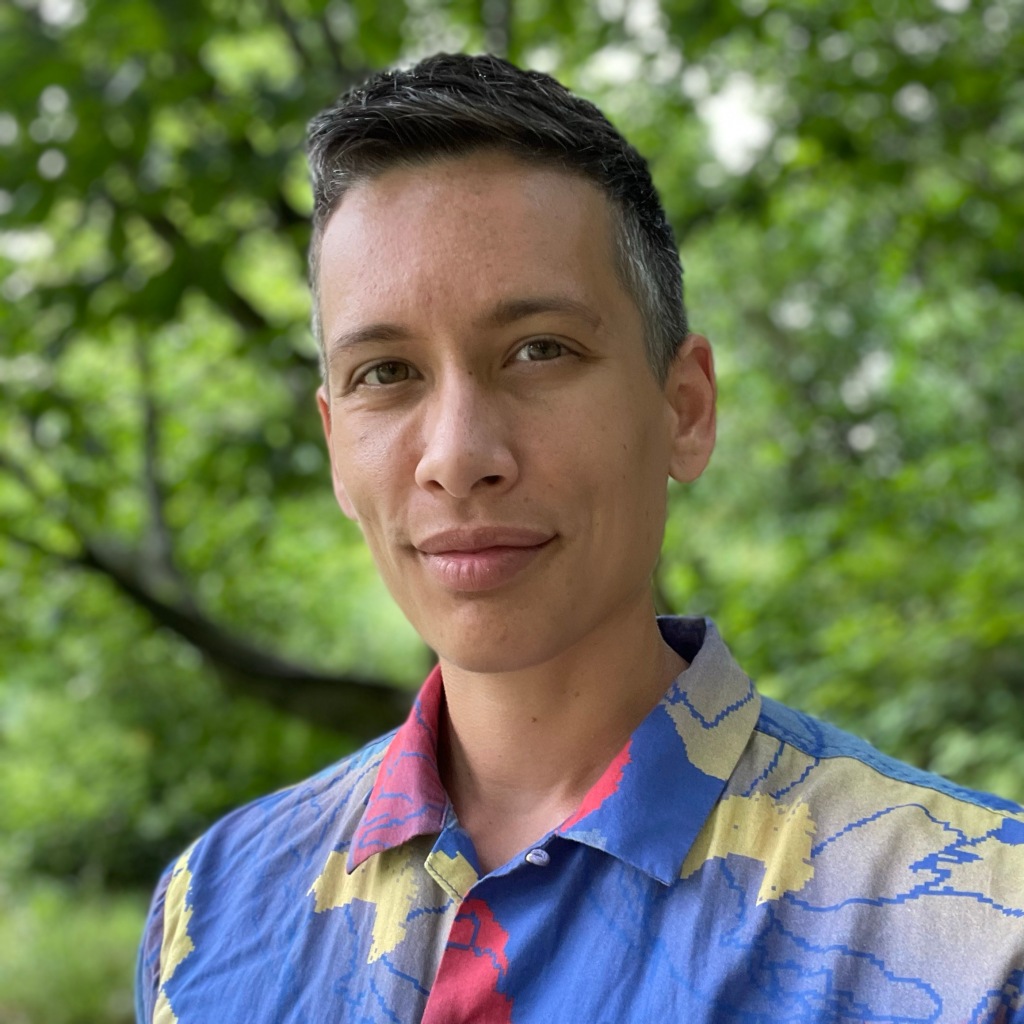
Of course, that’s a completely normal request – I have head shots (from a few years ago, but obviously I wasn’t going to use one of those!). No, it was because it dawned on me that this was the first time that I was introducing Tristan – just Tristan – to a global audience.
I wasn’t intending on announcing my presence to the world just yet. I guess I had assumed that my transition would remain amongst familiar circles until I was ready. But no, I had to get a head shot ready ASAP.
I wish I could say every interview went smoothly. Most didn’t question my male identity (and most strangers today ID me as a man). But a few did, and I won’t lie – it definitely stung.
The medical transition process (specifically referring to hormones here), which is akin to a second puberty, doesn’t happen overnight. It’s incremental, like the first puberty. Maybe I’m starting this process later than most, but it shouldn’t invalidate my journey or identity (there’s a whole separate conversation to be had here about the concept of passing, but I’ll leave that for another day). Talk to me again in 2 to 5 years. Anyway, I certainly didn’t ask for this during a professional interview.
In other news, our lab group spent a few days last week at Kristineberg Research Station for a work retreat and had a really nice time. It also conveniently coincided with the 2-month post-top surgery month mark for me, meaning it was also my first opportunity to go swimming (like properly using my arms and such)!
To mark the occasion, I jumped off a pier into some jellyfish-laden water of questionable warmth (good to know my swimming muscles still work after not using them for 2 months!) It was a great way to enjoy some of the last days of Swedish summer and celebrate my new chest.
Next week I’m off to Iceland for a few weeks for fieldwork! It will be my first trip abroad with my shiny, new passport and I can’t wait!
Starting the legal name/gender change process…
Well, it’s been a couple of weeks now since getting top surgery. Physically, I’m recovering swiftly and very happy with the results. My main struggle has been a mix of cabin fever and being forced to go from being very active to fairly sedentary. I’m finally allowed to lift more than 2.5 kg/5 lbs. so that’s a major step in the right direction!
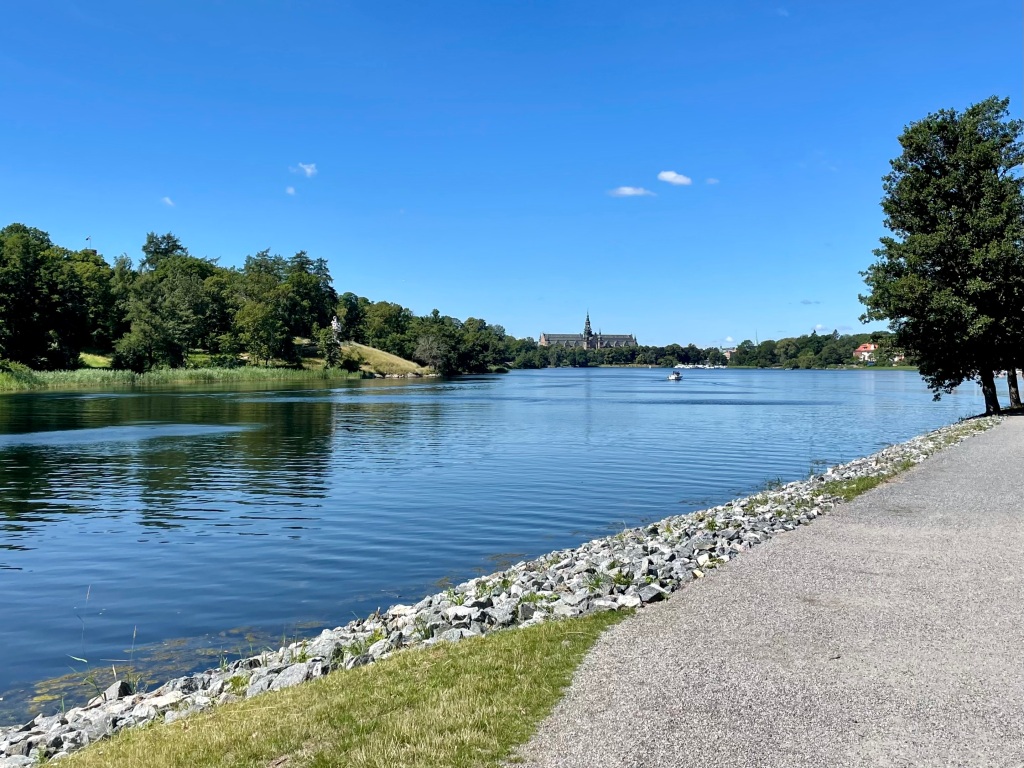
Last week I also (finally) initiated the process of changing my identifying documents. Because I am an American living abroad, my process for the name and gender marker change are a little different from an American living in the U.S. or a Swede living in Sweden. It’s been a pretty time-consuming process trying to figure out how to do this and I’ll be sure to post my process once I’m through and can confirm it goes smoothly in case it is useful to someone else (none of this has been intuitive). But for starters, I’ve changed my name in Sweden (a very easy process – literally was approved and I had the official paperwork within 30 seconds of my application/payment online). I was able to use this documentation to change my name on my U.S. passport at the U.S. Embassy in Stockholm. At the same time, I updated my gender marker on my U.S. passport. I also requested a notarized copy of my passport, which I can use to send to the U.S. Social Security Administration office in Norway (??!) to update my U.S. social security number (which will allow me to truly unlock changing my name in the U.S.). I went to the Migration Agency yesterday to update my residency permit, but they were only able to update the name because my information needs to match the information the Swedish Tax Agency (Skatteverket) has. So that’s awkward – my residency permit gender marker does not match my passport. Passport control is going to love me next time I travel.
Unlike the name change, changing one’s gender marker in Sweden is normally a long, multi-year process. Thankfully, as a foreigner, it appears I can cut this down to a few months with my updated passport (verified through correspondence with Skatteverket and on their website). I will have to get a new personnummer (these are apparently gendered), and I’m definitely not looking forward to going through this process again (as anyone who has moved to Sweden from abroad can probably understand). It’s hard to explain how important this number is in Sweden, but I might end up breaking my life for a bit once this gets updated. We shall see.
At this point, I’m refusing to put my life on hold. I will not let others hold back my transition and similarly, let my transition hold me back from experiences, opportunities, and living my life. Too bold? Perhaps.
Tangentially related – I’ve put a lot of time into researching some of the legal/medical/social/etc. logistics of transitioning, and have compiled a decent list of resources that may be helpful to transmasculine folks. After sharing it with several people, I’ve decided to make this resource public. It’s by no means comprehensive (and will be updated over time), but I hope it’s helpful to someone else.
Top Surgery!!
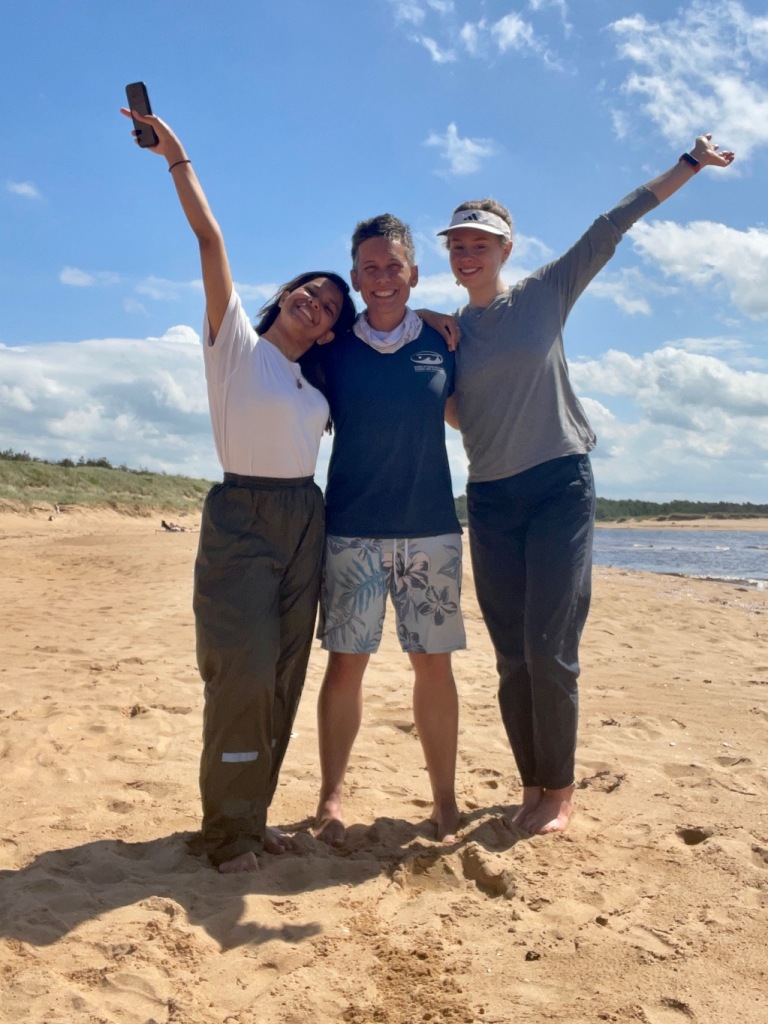
I realize it has been some time since my last post – I had a pretty crazy June between fieldwork and numerous deadlines (many international collaborators tend to ramp up their research in the summer while all of Sweden is wrapping things up to go on vacation for July). Oh! And I had top surgery on June 30!
Picture: Early June fieldwork crew
Let me start by saying, I hadn’t planned this. Yes, I’ve wanted top surgery for many years and had done tons of research on the procedures available, recovery, and risks, but the specific timing? No, I had 3 days notice.
Since moving to Sweden, I had weighed the options of getting top surgery through the public health system vs. privately. Factoring in wait times and mixed quality of results, I decided it was worth paying out of pocket to have it done privately (still cheaper than having it done in the US!). And after speaking to a few friends and seeing results online, I decided I would get top surgery at Reformkliniken with Dr. Tuve Mårtensson in Malmö.
My rapid journey to top surgery was a lot of crazy luck. First, it is nearly impossible to get a consultation appointment. Mid-June, I saw someone post on an online group that they had just gotten an appointment for the following week (presumably there was a cancellation). Not believing my luck, two appointments were available! I quickly checked my calendar and the price of train tickets to Malmö and booked the consultation for the following Tuesday. The consultation went well, and considering my schedule, I booked the surgery for the end of November. Optimistically, I’d hoped the surgery could have been done in July (no surgeries because the clinic operates on limited hours) or more realistically, October (booked up). But I was told I could contact reception to get in sooner on the off chance there were any cancellations.
I don’t think they meant the following week 🙂 I sent an email the Monday morning following Midsummer thinking there was no way there would be a cancellation. I almost didn’t send it, thinking I didn’t want to be a nuisance and the chances were absurdly low. The doctor replied within an hour saying there may be a cancellation that that he would know for sure by the afternoon, and by 3pm Monday I was booked for surgery Thursday morning!
I didn’t have time to get anxious, only excited. In short, I went from booking the consultation to getting surgery in 13 days. The next few days were a whirlwind of preparations. My supervisor offered to drive me back to Gothenburg from Malmö after the surgery and organize a meal roster, which I am immensely thankful for. I also live alone, so I had to frantically organize friends to stay with me, help me reach for things, etc. on very short notice, and during summer holidays.
I wondered if I was crazy for doing this – people talk about preparing for weeks before top surgery with elaborate checklists for post-operative care and comfort. But this wasn’t a flippant decision, this is a procedure I’d wanted for many years. Knowing that I planned to go private, I’d also already saved up the money and set it aside. I have also had several surgeries before, I know my body and I’ve had no issues with anesthesia and that I’ve recovered much faster than anticipated and easily from previous operations. Not to say that it is a given that it works that way every time, but it certainly eased my decision. I think academia also prepares you for dealing with highly stressful and unexpected surprises that somehow need to get resolved amongst an already crazy schedule (there’s certainly a conversation to be had about how healthy this is but it was definitely a helpful skill here!)
Wednesday morning, I was driving a box truck around Gothenburg to bring cruise supplies to storage and by the afternoon I was on the train to Malmö. The surgery was done late Thursday morning and I returned to Gothenburg by 10pm the same day.
I cannot begin to express my happiness with finally being able to feel a little more right in my own skin! My only regret is that I waited this long to get it done. Bonuses: pain has been minimal, swelling and numbness are pretty much gone, and incisions look great! This initial recovery period has been much easier than anticipated, though I know I will be physically limited for quite a while (something I will definitely struggle with). For those considering top surgery with Dr. Mårtensson, please feel free to contact me. I am happy to share post-operative photos and more about my experience.
I am also grateful for the people in my life – thank you everyone who has dropped by or sent me a message to see how I’m doing. It’s been absolutely heartwarming and appreciated.
One of the things that frequently gets neglected in the public discourse about trans people is the time and money required to transition. This isn’t just the medical aspect (hormones, surgeries, etc.), but also name and gender marker changes on legal documents, with the pathways to actually make these changes often unclear and with significant roadblocks. I am immensely privileged and feel fortunate that it is feasible for me to budget for these things, but that doesn’t mean they aren’t major burdens that detract from my free time and savings. I want to reiterate gender affirming surgeries and hormones are necessary medical care, yet frequently the public and governments treat them as elective. I’m envious really, that so many people don’t have to experience this burden. Yet at the same time, most will never experience the inexplicable joy that also comes with the before/after contrasts of transition – and those experiences are worth the effort a thousand times over.
International Day Against Homophobia, Transphobia, & Biphobia
I have been pretty busy lately planning and organizing fieldwork coming up in a few weeks. Things are thankfully starting to come together. The funny thing about travel though, is that it’s one of the few times I really become aware of my identifying documentation. For instance, I’ve booked accommodation under my deadname and my driver’s license doesn’t reflect any changes (the wonderful combination of biking everywhere and efficient public transport means I only drive when doing fieldwork these days). I don’t think anyone looks very closely at these types of things, but I’m sure it will come up sometime in the near future.
Today is also International Day Against Homophobia, Transphobia, and Biphobia. For this occasion, I did an interview with University West (Högskolan Väst) about trans issues in Sweden and abroad. I struggled with how forthright I wanted to be for this interview (relatedly, something I also wrestle with in the context of this blog). I haven’t been in Sweden long, and as a non-Swede, I am especially cautious about offering honest feedback on trans issues in Sweden (and as an American – I have no room to talk!). But after chatting with a friend, I realized this is an issue of lack of awareness and that [some degree] of commentary could be beneficial for (especially cis) people to hear. Maybe I’ll get chased out of the country, hopefully not.
On a personal note, I ran my first trail race (Trailvarvet – 11.5 km through Änggårdsbergen) over the weekend (also first race since December 2019)! Incidentally, this was also the first sporting event I’ve competed in under the “male” category. I kept waiting for someone to call me out (despite the fact that it would have been distinctly unfair for me to compete as a woman at this point). No one did – it was a pretty awesome feeling 🙂
Been a little busy…
Oof, I have been busy lately and I’m realizing it’s been several weeks since I last blogged. Proposal season is in full swing (I just submitted my first “adult” proposal as PI!) amongst manuscript deadlines and planning multiple fieldwork excursions.
With numerous applications due, I’ve been encountering a common theme lately: what name and gender do I apply under?
An example: to register with the major research/funding application portal in Sweden, you need to add your Swedish social security number (personnummer). This number is used for pretty much everything in Sweden and has your birthday and (binary) sex coded into it. For instance, when I joined a gym in Sweden, I had to provide my personnummer and with this information, the online form auto-filled in my legal name, gender, birth date, and address. Generally speaking, it’s a beautiful system, but it doesn’t allow much give for people whose name and gender do not match their reality.
-Thankfully- the support at Prisma and Formas has been super helpful and have confirmed that I can submit the application as a man named Tristan. This kind of flexibility I hadn’t yet experienced in Sweden and I’m very thankful for this. FYI – they are also allowing folks to apply as nonbinary (!)
I’ve also been applying for faculty positions and trying to reconcile my mismatched identity and experiences. First, I’m still waiting for the publishers to update my name on a few of my previous publications (so that is unfortunately inconsistent). As an early-career researcher, I really need to have all my research output reflected in my application. I have decided it is best for me personally at this point to add my deadname to my CV (“formerly known as”) to eliminate any uncertainty about my identity. Second, most of my experiences in STEM have been presenting as a woman or as nonbinary (which unfortunately most people still read as “woman”). While I’ve always been a man, it doesn’t fully encapsulate my lived experiences. One way I’ve been addressing this is through outing myself in my diversity statement – it’s not perfect, but I also acknowledge that there is a degree to which I need to lean into “being out and proudly trans”.
With all of that said, I’m optimistic that the uncertainty I’m experiencing with application processes right now will become more streamlined for trans* folks in the future. Society is increasingly acknowledging that things need to change for the better, and while it’s certainly an imperfect process, change is happening.
Keeping it together…
I will start by saying that coming to terms with my gender and pursuing transition has been the greatest gift to myself. The positives significantly outweigh the burden of stress associated with transition.
On its face, I have everything figured out. Complete composure. But there’s a lot that people don’t see.
For instance, I’ve dedicated many hours researching how to change my name and gender marker (legally, socially, professionally). The current societal structures make this unnecessarily difficult, and I won’t lie, there have been multiple times I’ve questioned if it’s actually worth the stress. I’ve come up with a very convoluted pathway to change my name and gender marker in both Sweden and the US, but I will be fighting government agencies the whole way within a narrow time window (because I also need to be doing research!)
One may wonder, why do this now? I am doing this now for several reasons:
- Because I can – I don’t know where I will be living in the next few years and it flatly may not be possible.
- Safety – not being outed by my ID.
- Sweden is frustratingly bureaucratic without compassionate flexibility.
What do I mean by this last one? My name and gender are linked to my Swedish social security number. This is linked to my employment (and pretty much literally everything I do in Sweden). For instance, at work, I have zero control over my name (i.e., sender name in emails; Microsoft 365 account, Zoom, etc.). I have found workarounds for most of these things (see Trans* Name Change Guide), but there is no option for a “preferred name” and no means to change it without a legal change. Same for gender and travel – all travel through work for some reason requires a Ms. In front of my name. I even attempted to see if they could just use Dr., but nope! It is Ms. or Mr. and it must match your legal gender. I’m not even going to begin to talk about the lack of nonbinary options here (what would they have done if I’d moved here with an ‘X’ in my passport?!) And trust me, I’ve tried, others have tried on my behalf to change this… And while individuals have all been all super apologetic and sympathetic and that they wish they could help, the system is so rigid in a way that is bluntly dehumanizing. On the other hand, I have found Swedish society very accepting of trans people and generally very safe. I like Sweden! But my experiences as a transitioning person in Sweden from a logistics perspective have been less than stellar.
And there is stress associated with transitioning itself – I’m changing not only my outward appearance, but also adjusting to changes in how my brain functions (it definitely feels more correct now). For instance, between weightlifting and the testosterone (I’m so hungry!), I’ve put on a little extra weight around my hips (still getting the feminine body fat distribution, hopefully this will change soon). Despite that this is nothing that anyone else would notice, I’m finding it harder to get dressed in the morning because of the more feminine shape. Another example – I find my voice is still too high. These are things that have plagued me for a long time, but that I’ve just sucked up. Yet now that I’m actively pursuing these changes, I find myself more bothered, less patient, and less compassionate for the person in the mirror. I have a tough outer shell, but these things take up mental and emotional space and time.
I was talking to a colleague this week and mentioned a few of these things, and his response was, “How are you doing all of this on top of your postdoc fellowship and still sleeping at night?” Truth is, I have no idea. And yet, I’m happier. I feel more me – which is something worth fighting for.
Trans* Name Change Guide!
First, an *announcement* – Version 1.0 of the Name Change Guide for Trans* Academics is live! I’ve been taking notes as I’ve been going through the process – I hope this can be useful for someone else. Feel free to reach out to me if you have questions, comments, concerns – or if you want to contribute to this guide or other resources in the future!
Otherwise, I will stick to a quick update this week – of course there is a lot going on in my life, both personally and professionally, but it’s mostly positive, so I will take that as a win. Amongst the positives in my life, I’ve been feeling a bit down this week because the changes are happening rather slowly and I’m impatiently waiting to move forward with my life as me. Yes, I know it’s a process and all part of the journey, but the desire for an overnight switch is definitely there. Fortunately, I got a boost mid-week when I learned my name on the first of my previous publications has been updated! Tristan is happening!

This was my first major publication (from my undergraduate research!), so it seems appropriate that it was the first one updated as well. I actually felt the same pride when I saw the name change as I did when I first published this paper. And as promised, there is no evidence of the change (correction notices, changes in publishing/record updated date, etc.) I have to admit, that felt pretty good.
More to come…
That In-Between Space…
I’ve been feeling like my life lately has been a lot of paperwork, logistics, and constantly having to put myself out there. I’m continuously coming out to new people and traversing this odd space of having two different simultaneous identities.
I’ve been working through changing my name on my previous publications – this has been a somewhat frustrating process. First, I want to say that I’m very thankful for the work done by the Name Change Policy Working Group, which resulted in trans inclusive name change policies by most major publishers in 2021. These policies are intended to protect the identity and safety of the author and allow for “silent” or “invisible” name changes, meaning no correction, corrigendum, or editorial comment is associated with the change. The online and PDF versions are edited, the doi remains the same, and the corrected metadata gets sent out again journal indexing databases.
Despite having a very direct approach to emailing journals about my request –
“Hi I’m trans and would like to change my first name from x to y “invisibly” on z publication according to your trans-inclusive name change policy (insert URL to publishers policy)…”
– I’ve found myself having to explain to journal editors their own policy. Multiple journals initially replied to me saying that it would not be possible to do without an editorial comment or corrigendum. But after I pressed further (and I assume my persistence caused the people I was emailing to check with someone higher up), I successfully convinced every editor of their own policy. I try to remind myself that because these policies are so new, this is probably the first time these editors are encountering this change. It’s been an exercise in patience and pausing before hitting send, but I’m happy to report that all my previous publications will reflect my new name very soon!
I can only speak for the experiences with the journals I’ve published with, but Wiley, Elsevier, Springer Nature, and PLOS did not require any legal documentation of a name change. Someone on Twitter recommended that for Elsevier journals to email the individual journal, not the email they provide for name changes, and I can confirm, this is the way to go. Weeks later, I have not heard back from that email address (I assume it’s un-monitored), but individual journal editors were on it within hours.
Why bother with changing my name on my publications?
I did consider not changing my first name on my previous publications, especially because my previous name and photos are everywhere – and that will be impossible to expunge. But as an early career researcher, I decided it would be best to have a consistent record for the most critical part of my academic identity. And on a personal level, while the change is subtle – it’s a single letter added to my first name – it feels affirming.
I’ve been also slowing coming out to various collaborators. I could just “not mention” I added an ‘n’ to the end of my name (a lot of people called me Tristan before anyway by accident or inattention) or changed my pronouns in my email signature and see who figures it out, but that leaves a lot of room for someone to wonder or make assumptions. My approach has been to address it head on by adding a short, but to the point, comment about it at the end of an email. It’s honestly terrifying, but so far, it’s going well? There’s no handbook for these things – I’m really just winging it at this point.
Amongst all of this, I’m keeping up with manuscript and grant writing, and my ongoing research projects. Sometimes I wonder how I can keep so many balls in the air at once, but in truth a good to do list really goes a long way. I’m doing it, pushing forward, and onward and upward!
That said, I am so excited for when this process is over – when I’m secure in my appearance and documentation and I don’t have to keep clarifying or justifying my existence. I’m looking forward for when I can just move through the world as me without explanation.
The days are getting longer again in Sweden and the sun is out! I’ll take this as a good sign that the future is looking bright!
